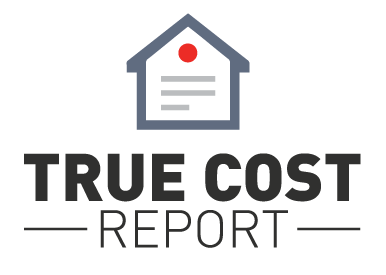Why Pricing Matters:
Introduction & Executive Summary
Nobody enjoys overpaying for anything or feeling ripped off. For most purchasing decisions, from small items to large items, we are all doing mental math to see if the price aligns with our perceived value and quality. In general, we want the highest quality at the lowest price, expecting reliability, functionality AND affordability.
To put this equation into a broader context, every dollar spent by one person is a dollar earned by someone else. This delicate equilibrium between spending and earning is what drives our economy. For some common goods and services we regularly purchase as consumers, we understand why they cost what they do. However, for home services like home improvement projects, maintenance and emergency work done in and around your home, cost has always been uncertain and difficult to assess.
With digital marketplaces like HomeAdvisor, we have an opportunity to better understand the cost of home services. For the market to work as well as possible, it is also important for homeowners to understand what different home services cost and to understand what drives those costs.
An informed consumer makes the market stronger by putting themselves on an equal playing field with contractors and service providers using information to gauge what is fair and realistic. Consumers have an important role to play in helping the market improve, and the results of improvement are better products, services and trends. Further, price is what we use to balance scarcity (aka availability of labor) across all markets, so understanding pricing matters.
An informed consumer makes the market stronger by putting themselves on an equal playing field with contractors and service providers using information to gauge what is fair and realistic.
An informed consumer will also better understand home services labor costs. Unlike purchasing a traditional consumer good, such as a smartphone, where wages earned by those along the supply chain shift across manufacturers, distributors, researchers, shareholders, company executives and retail tradespeople, purchases in home services contains a significant amount of labor cost that is directly observable to the consumer. They see the tradespeople doing the work right in front of them and often see labor directly on the contract or as separate line items in the cost of the project. This means the quality of that labor is particularly important, and consumers need to understand all the different ways that quality varies.
Following a year in which spending pivoted to the home, we are going to take a deep dive into exploring the cost of the top home service projects of 2020.
- Interior Painting Costs: $2,007. Completed by 35% of households.
- Bathroom Remodel Costs: $13,401. Completed by 31% of households.
- New Flooring Costs: $4,680. Completed by 26% of households.
- Landscaping Costs: $2,389. Completed by 24% of households.
- Kitchen Remodel Costs: $35,317. Completed by 23% of households.
- Exterior Painting Costs: $3,291. Completed by 19% of households.
- New Smart Home Device Costs: $205. Completed by 19% of households.
- New Roofing Costs: $9,375. Completed by 16% of households.
- New Fencing Costs: $2,991. Completed by 16% of households.
- Cost to Install Deck or Porch: $3,291. Completed by 14% of households.
Part 1. What Do Common Projects Cost?
The top three projects of 2020 were interior painting, bathroom remodels and new flooring, according to our 2020 State of Home Spending report.
35% of households that completed an improvement project undertook some type of interior painting, while 31% completed a bathroom remodel and 26% installed new flooring.
Interior painting is an unsurprisingly popular project. At an average cost of $2,007, it is the third lowest cost project in the top 20 after installing home office networking and smart home devices. However, unlike networking and smart home devices, interior painting can have a massive visual impact on your home. This balance between high visual impact and relatively low prices can explain the popularity of several of the top projects.
The sweet spot of affordability plus a large visual impact
is likely also what drives the relative popularity of flooring ($4,680 and 3rd most popular project), landscaping ($2,389, and 4th most popular project) and exterior painting ($3,291 and 6th most popular project). These are low in cost and high in popularity, making them ‘visual-value’ projects, as they typically make a big visual impact for a relatively low price.
The sweet spot of affordability plus a large visual impact is likely also what drives the relative popularity of flooring, landscaping and exterior painting.
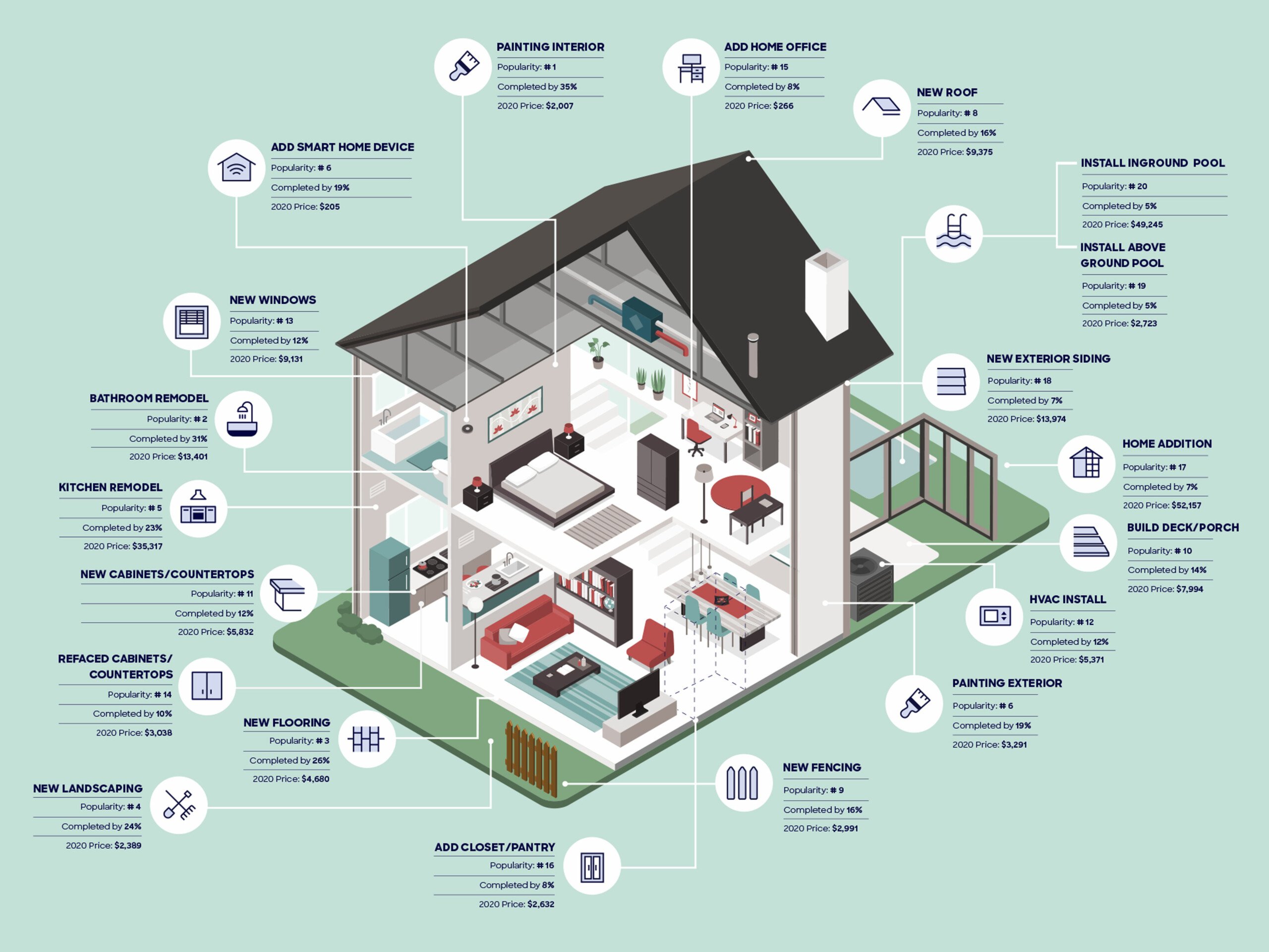
Of course, not all high popularity projects with high visual impact are what we would typically think of as ‘cheap’.
Bathroom remodels were the second most popular project with a significantly higher average cost of $13,401. Similarly, kitchen remodels were the 5th most popular project with a much higher average cost of $35,317. These two projects are both expensive and popular, which is why we commonly call them ‘lifestyle-value’ projects.
As you can see, price is not
the only factor in a project’s
popularity. On the other end of
the spectrum, a relatively low
price does not necessarily mean
a project is uniformly popular.
‘Lifestyle-utility’ projects are low-
cost projects that are also low in popularity, such as installing a pantry or adding new fencing or new roofing. Finally, there are high-cost, low-popularity projects like new home additions or inground pools, which were 4th and 1st least popular projects of 2020 and have median costs of around $50,000 each. These are considered ‘luxury or necessity projects’ because they are not completed often, both due to the scope of the work and the cost of the project.
| 2020 Rank | Project | Percent Completing | 2020 Price | 2021 Planning Rank |
|---|---|---|---|---|
| 1 | Interior Painting | 35% | $2,007 | 2 |
| 2 | Bathroom Remodel | 31% | $13,401 | 1 |
| 3 | New Flooring | 26% | $4,680 | 3 |
| 4 | Landscaping | 24% | $2,389 | 4 |
| 5 | Kitchen Remodel | 23% | $35,317 | 6 |
| 6 | Exterior Painting | 19% | $3,291 | 5 |
| 7 | Smart Home Device | 19% | $205 | 8 |
| 8 | New Roofing | 16% | $9,375 | 12 |
| 9 | New Fencing | 16% | $2,991 | 9 |
| 10 | Deck or Porch | 14% | $7,994 | 7 |
| 11 | New Cabinets | 12% | $5,832 | 11 |
| 12 | New HVAC | 12% | $5,371 | 13 |
| 13 | New Windows | 12% | $9,131 | 10 |
| 14 | Refinish Existing Cabinets | 10% | $3,038 | 14 |
| 15 | Home Office | 8% | $266 | 17 |
| 16 | Pantry | 8% | $2,632 | 16 |
| 17 | Home Addition | 7% | $52,157 | 15 |
| 18 | New Siding | 7% | $13,974 | 20 |
| 19 | Above Ground Pool | 5% | $2,723 | 18 |
| 20 | In Ground Pool | 5% | $49,245 | 19 |
…a relatively low price does not necessarily mean a project is uniformly popular.
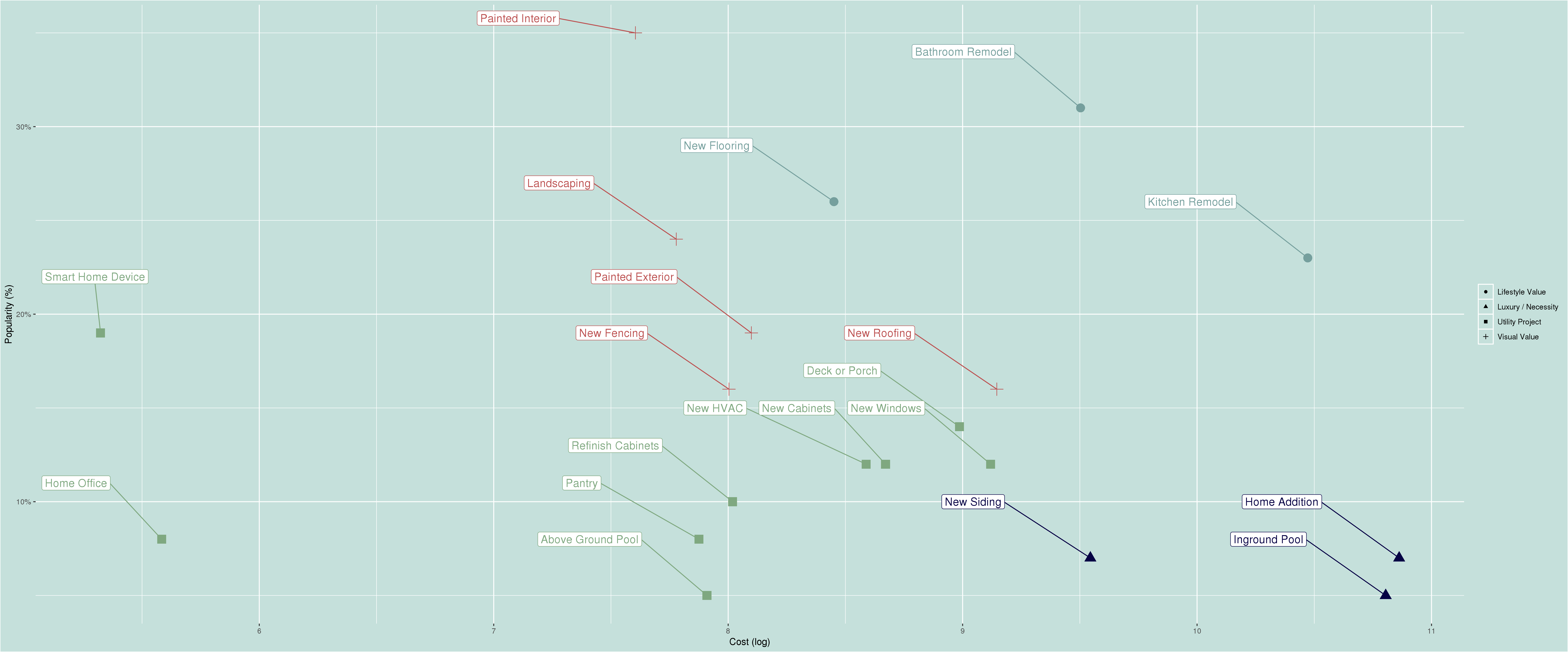
Part 2. How Costs Have Changed
Prices are constantly changing in every industry and prices for home service projects are no exception. In 2020, additions, closets and cabinetry saw the biggest rise in pricing, with project prices increasing from 2019 by 49%, 38% and 30%, respectively. Conversely, computer networking, smart home systems and above ground swimming pools all dropped in price on average, falling 10%, 37% and 43%, respectively.
Prices likely rose for cabinets, closets and additions because lumber prices for materials like plywood, OSB and framing lumber all rose dramatically in 2020 as a direct or indirect result of COVID-19.
When thinking about home services projects, there are many drivers of cost including labor and materials supply. For some of the projects where we saw price increases or decreases over the last year, it can be attributed to supplies. For example, home networking and smart home devices both include consumer electronics, which are notorious for prices dropping while quality improves. So, while the cost of installing these devices might have remained the same or risen, retailers and manufacturers have, on average, driven down the price of options for smart home devices through deeper competition and continued innovation.
In contrast, prices likely rose for cabinets, closets and additions because lumber prices for materials like plywood, OSB and framing lumber all rose dramatically in 2020 as a direct or indirect result of COVID-19.
Prices can also drop not because of the underlying price of the materials, but because consumers may be substituting for cheaper options, lowering the overall average price paid. This is probably what drove down the price of above ground pools: there is a wide range of options and quality available in that category and the 2020 COVID-19 recession could have made people in the market for this project type more price sensitive and more likely to opt for more utilitarian options while preserving their savings.
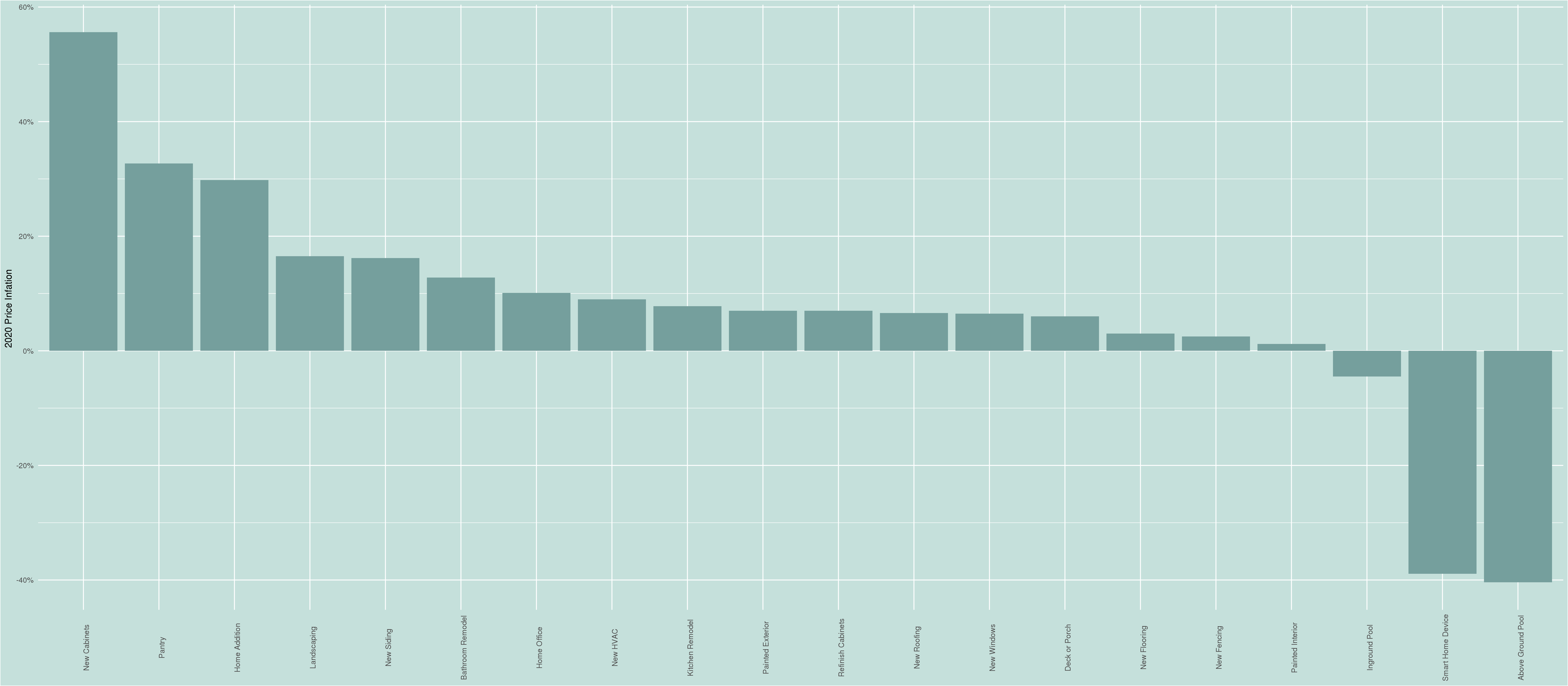
But across the market, and in years not impacted by a once in a century global pandemic, what can we consistently look to as drivers of higher project costs?
- Scarcity due to higher demand.
If demand goes up quickly, supply chains for home improvement products take time to catch up, resulting in scarce products and prices being bid up. For example, a boom in remodeling and home construction in 2020 resulted in more building materials like framing softwood and panel goods like OSB and plywood being bid up, in some cases even tripling prices. - Scarcity due to lower supplies.
More demand can drive prices, but so can fewer supplies of materials. Material shortages can come from a variety of shocks to supply and production chains, such as natural or man-made disasters. In 2020, lumber mills and distributors shut down or reduced shifts as a result of COVID-19, which resulted in less supply on the market and higher prices. - Tariffs.
Tariffs can also impact prices, whether they’re new tariffs, such as those added to Chinese imports over the last several years, or longstanding tariffs, such as those caused by the dispute over Canadian softwood lumber that has been ongoing for the last 40 years. - Quality improvements.
Prices can also rise as the quality of products rise, particularly for projects that include a variety of goods. Take kitchen remodels as an example, which include wood, paint, metal, appliances, electrical and plumbing products. More complex appliances or faucets, more reliable and multi- functional electronics, or better grades of tile, stone and flooring can all lead to higher cost remodeling projects. - Consumer demand for labor fairness or sustainable products.
These are reasons closely related to the increase in product quality, but which also overlap with labor quality. Consumers are increasingly demanding goods and services from companies that view their social mission in a broader context. In the short run, at least, this usually means paying a little extra for more sustainable products or products from companies with higher labor standards. - Wage growth.
Labor is a significant and important component of remodeling projects (see part 4). As with any industry, home services has to attract more people to do the work through higher wages, especially when the supply of labor is competitive elsewhere in the economy. So, during periods of elevated wage growth like 2017, 2018 and 2019 when hourly wages were rising by nearly a dollar every year, prices for remodeling projects also rise.
In addition to local labor market conditions impacting individual wages, the prices for manufactured goods and raw materials are also constantly changing. Looking at product inflation over the last 5 years, remodeling a kitchen has grown the most, with the average expenditure going up over 50%, with additions and custom cabinets following closely behind.
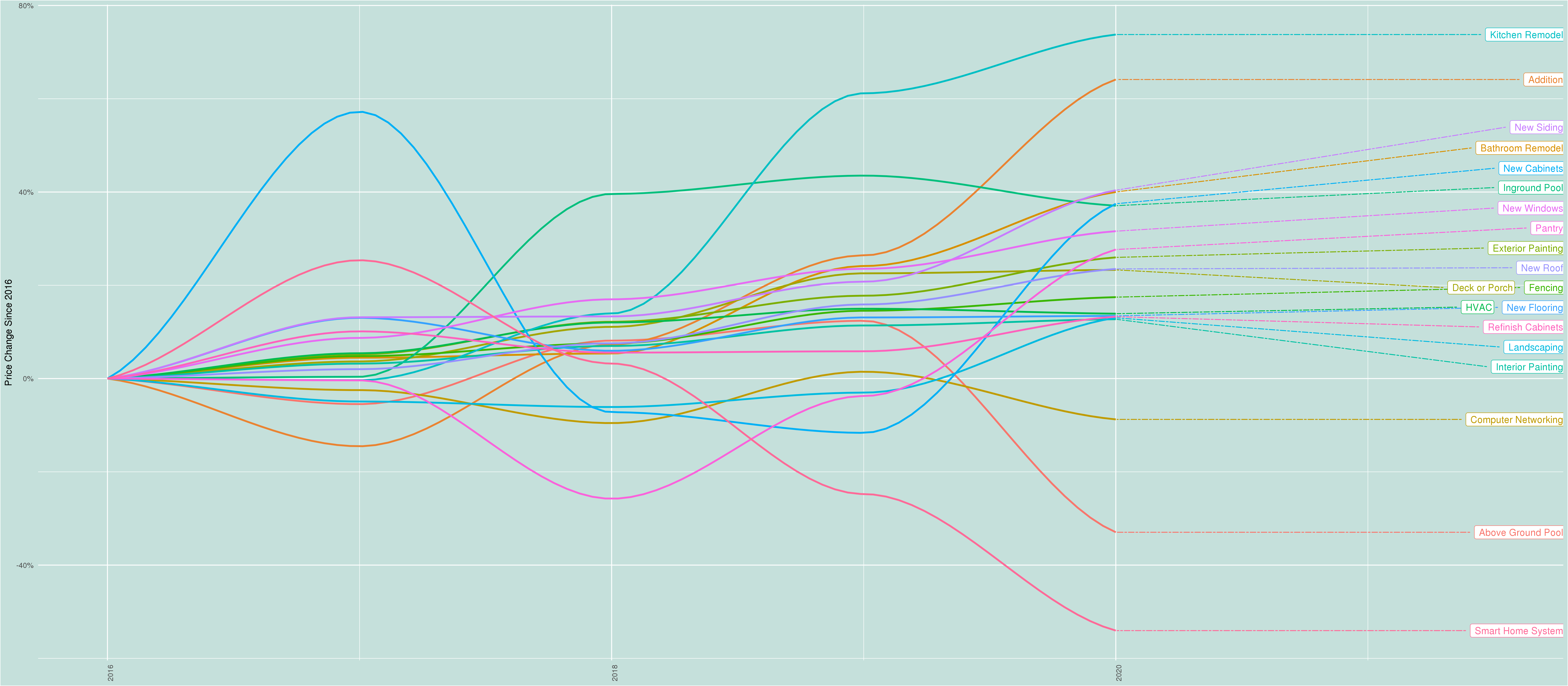
Part 3. Why Are Costs Higher or Lower? A Model for Pricing
In the first part of the report, we described average project costs and in the second part described how those prices have changed over the last year. Now we’ll look at why individual costs deviate considerably from the average within each category.
For example, with above ground pools and smart home system installs it is not uncommon for a
half of all projects to be 50% more expensive or 50% less expensive than the average. However, in roofing, remodels, refacing cabinets or installing an inground swimming pool, the prices consumers pay tends to cluster closer to the average.
So why do costs vary so much within each given project type?
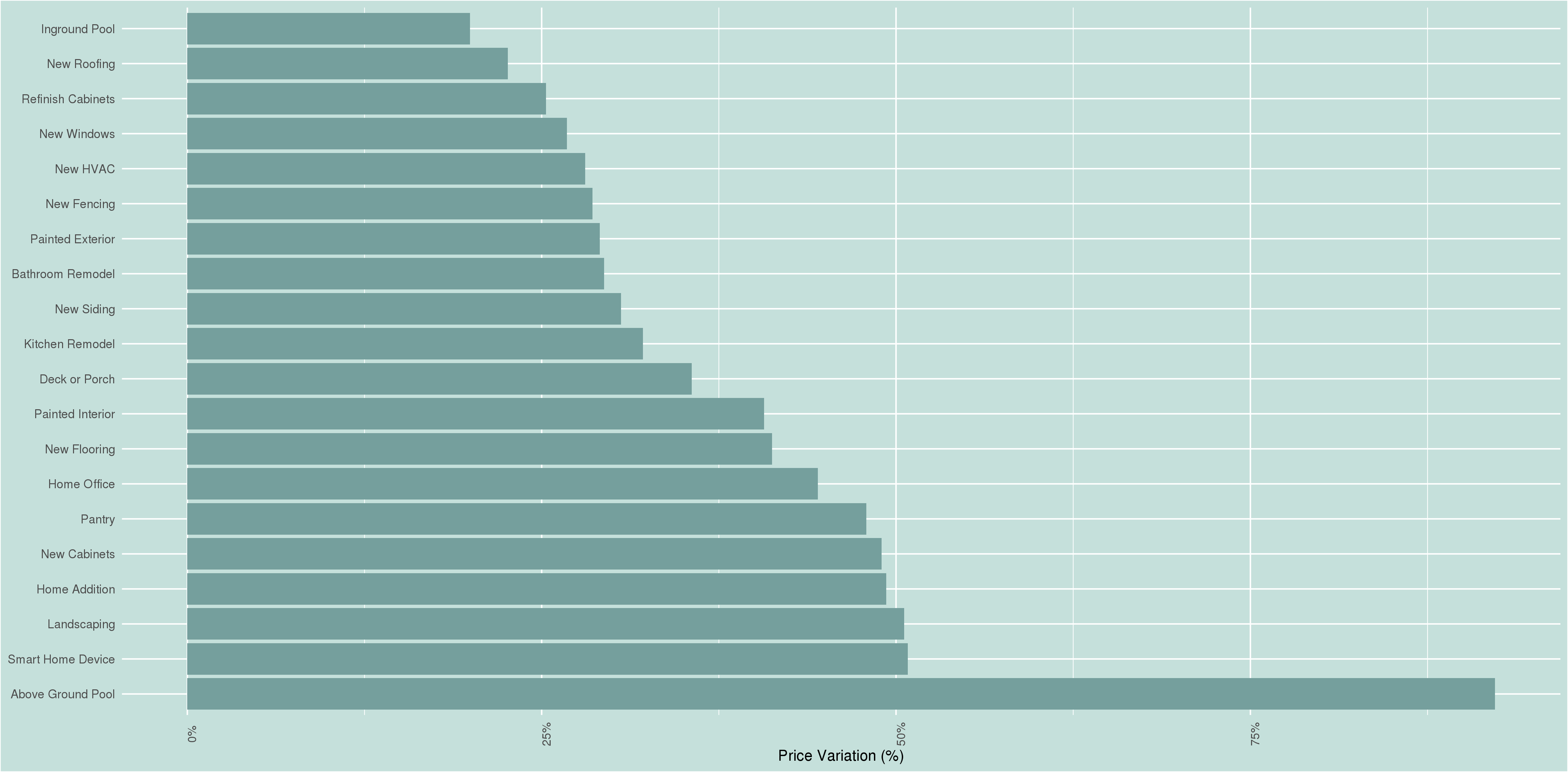
Home projects are composed of two parts: products and labor. Products can vary drastically in quality. On one end, we can choose to use raw materials like furniture-grade plywood, oriented strand board for walls and floors or dimensional lumber for things like framing new walls. On the other end are materials like off-the-shelf, ready to install products, such as pre-made cabinets from a big-box store.
Variance in materials can result in big price differences, independent of labor costs. Even two materials that are identical to install can range dramatically in terms of pricing, such as wood trim made from an expensive imported hardwood vs. a stained pine. However, not all products are equal in terms of labor costs. While it is true that some more expensive materials might mean easier and faster installations, such as prefabricated joists used in a remodel, it is often more likely that more expensive materials require disproportionately higher labor costs. For example, a high-quality imported large format tile that requires an extremely level underlayer before installing will have higher labor costs relative to a standard smaller format tile from a big box store where the underlying floor does not require as much precision.
What all this means is that cost itself can be understood as a product of four major factors, which we can model by looking at:
- Material quantity
- Material quality
- Labor quantity
- Labor quality
Variance in materials can result in big price differences, independent of labor costs. Even two materials that are identical to install can range dramatically in terms of pricing, such as wood trim made from an expensive imported hardwood vs. a stained pine.
Each of these factors has its own cost profile that raises or lowers the total cost for any given project type. So, in order to understand why prices vary, we can look to each one of these as factors to determine total variability between jobs.
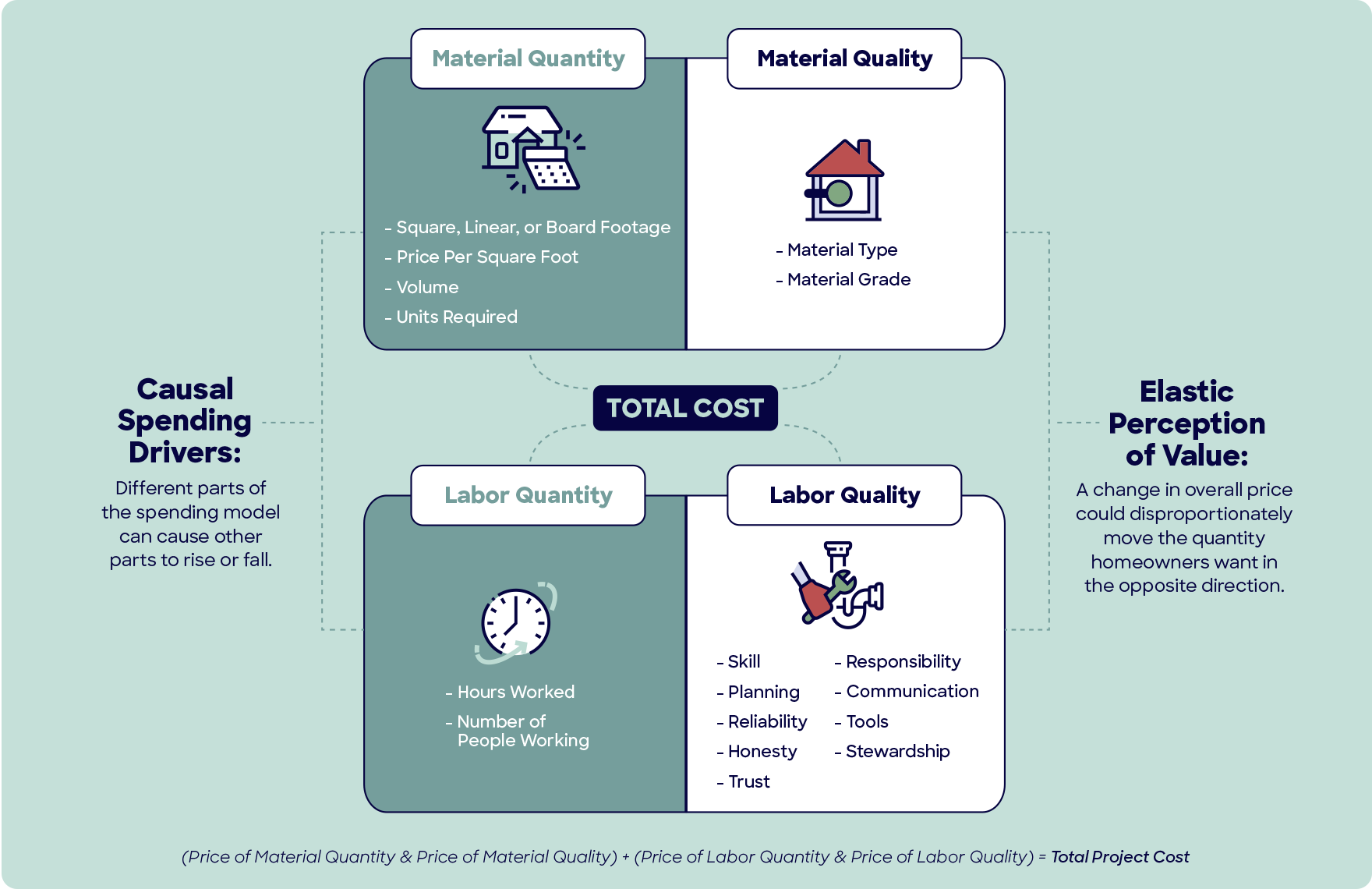
1. Material quantity.
Material quantity is often a simple matter of arithmetic. For some projects, when covering a surface with one material, we can multiply the length by the width, add on a small amount of material loss due to cutting and waste (typically 5% to 10%) and end up with the necessary square footage quantity. For other types of jobs, it can be as simple as the linear length, a per unit cost or a per volume cost. Regardless, the arithmetic remains relatively straight forward.
2. Material quality.
Material quality is not dissimilar. Pick your level of quality and grade within that quality band, and that sets the price level to multiply by your quantity. Roofing project costs in 2020 are a great example of this.
Average cost of asphalt roofing: $9,368
Cost of metal roofing was slightly higher at $9,971
Cost of wood shake roofing was higher still at $15,183
Tile roofing project prices averaged $30,050
Natural slate roofing costs the most at an average of $35,163
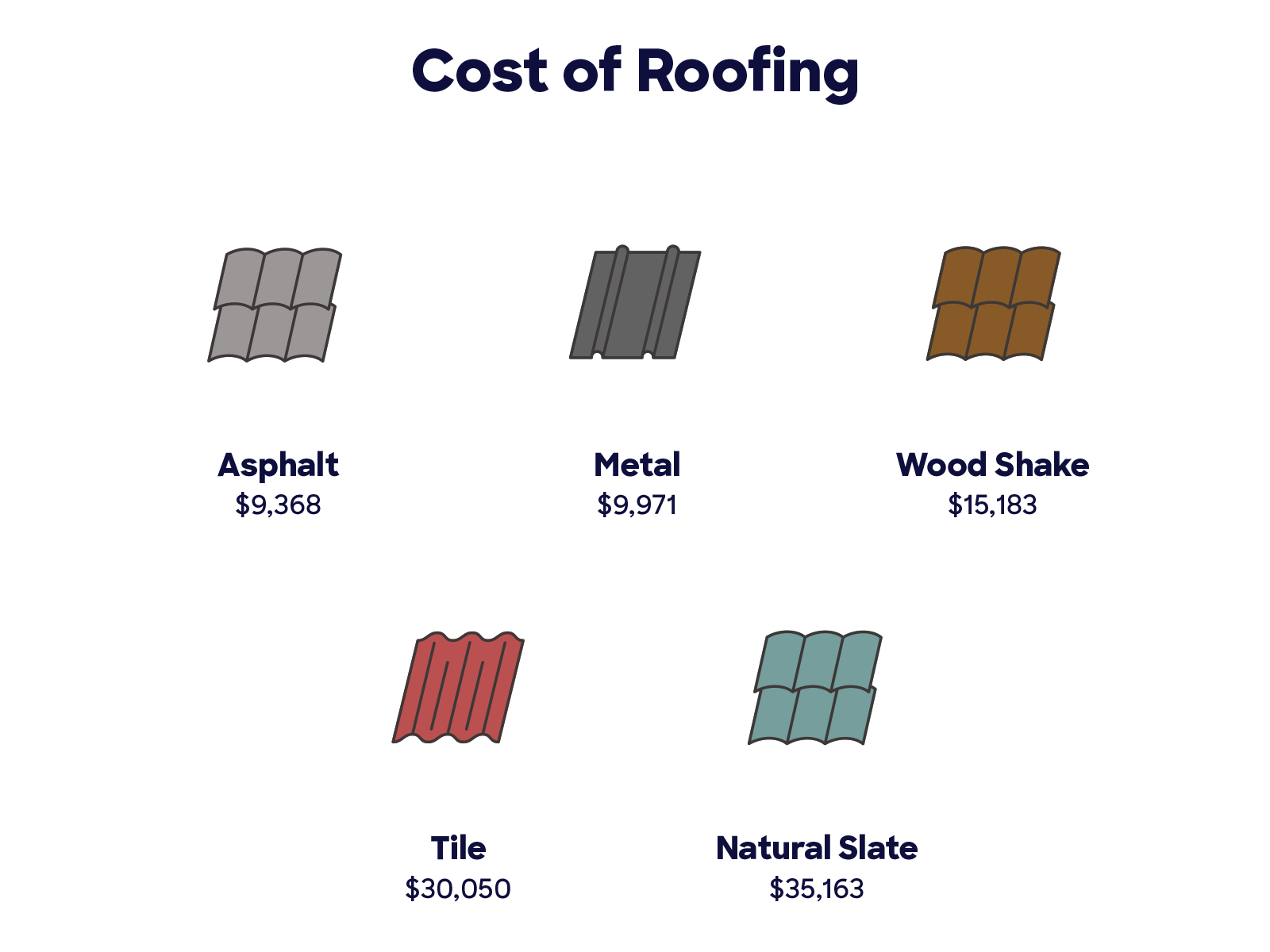
3. Labor quantity.
Labor quantity is a calculation of the number of people required for a job and the number of hours they work. While some jobs, like painting, typically require a certain number of person hours worked, regardless of how many people are working simultaneously, other jobs, such as a complicated concrete pour, require a minimum number of people working concurrently to make sure projects go smoothly.
4. Labor quality.
Labor quality is the fourth and final component of cost and
is simultaneously the most important and the hardest to measure, which is why we describe it exhaustively in the next section. An entire project is contingent on the skill, experience and wisdom of the craftspeople doing the work, but the quality of labor is harder to assess, measure and understand.
While some jobs, like painting, typically require a certain number of person hours worked, regardless of how many people are working simultaneously, other jobs, such as a complicated concrete pour, require a minimum number of people working concurrently to make sure projects go smoothly.
In addition to the four component parts of this model used to understand job costs, there are two additional and important dynamic effects:
a. Dynamic Effect A
Dynamic Effect A, Causal Spending Drivers: Different parts
of the spending model can directly cause other parts to rise
or fall. For example, a larger house might be owned by a wealthier household with a higher budget for a roofing remodel. So, the house structure may have more material usage and the material quality may also be more expensive. Simultaneously the large complex job and the expensive materials could also drive up the cost of the labor to ensure careful, proper installation by requiring both more labor hours worked and more talented tradespeople.
b. Dynamic Effect B
Dynamic Effect B, Elastic Perception of Value: A change in overall price could disproportionately move the quantity homeowners want in the opposite direction of the price change. For example, if the price of redoing 500 square feet of landscape drops by 20%, homeowners might perceive this new price as representing such great value that instead of redoing a small 1,000 square foot portion of their yard, they decide to redo their entire 2,000 square foot lot. This means that prices would drop by 20% but the overall amount spent on the landscaping project would increase by 160%. Conversely, if prices rise by 20%, homeowners might respond by halving the amount they were planning on redoing. In this case, a 20% increase in the landscaping area price results in a 60% reduction in the overall price of the job.
Part 4. Understanding the Importance of Quality Labor
Three of the four major components of project costs are easy to measure and straight forward to understand.
Material quantity is just a matter of measuring area precisely (or volume, units, etc.), then considering how much material might be lost to error, waste, breakage or unusable offcuts. Labor quantity is likewise a matter of measuring the hours and the number of people required to get the job done.
Similarly, material quality is also relatively simple to measure or anticipate. For example, slate is more durable and more expensive than metal and metal is more durable and more expensive than asphalt. All are commodities sold on open and efficient markets with clear pricing. Wood quality is also graded off the shelf with ideal grain patterns and fewer knots graded higher than knotty wood with inconvenient grain. When material choice can be driven by cultural or trend- based factors rather than durability, as long as the market supplying the materials is competitive, a consumer’s options will come down to some other form of similar, comparative grading.
But how do we accurately and transparently assess labor quality? To dig into this, let’s start by considering painting. Interior painting was the top project of 2020, with exterior painting tied for the 6th most popular project.
A common perception of a painter is the untrained college student quickly throwing a coat of paint over a wall of your house and calling it day. Alternatively, painting can be seen as an easy DYI project for a couple looking to have a fun afternoon together tackling a home project. No need for a professional at all, right?
In actuality, even something as outwardly simple as painting can have a tremendous amount of expertise and talent built into the price you pay for your painter.
In actuality, even something as outwardly simple as painting can have a tremendous amount of expertise and talent built into the price you pay for your painter.
Being a high-quality painter requires far more than just a willingness to spend some time with a roller and a brush, and there are several determinants that can indicate the quality of the painter.
Being a high-quality painter requires far more than just a willingness to spend some time with a roller and a brush, and there are several determinants that can indicate the quality of the painter. When paying extra for a quality painter, you are also getting someone who:
- Will be fastidious in ensuring that masking and covering services are done safely, minimizing risks to your furniture and décor.
- Ensures crisp lines and edges, appropriate caulking on joints, and the right rollers and brushes to match both the texture and sheen of your finished surface.
- Is responsible around the environmental clean-up following your job.
- Guarantees on-time arrivals and departures and remains conscientiousness around lifestyle impacts to you and your family.
- Has the ability to perform other functions such as helping guide interior color choices or consulting on the maximum life span of the product they are applying.
- Matches stains to your climate and weather for maximum durability.
- Finds areas of failing weather barriers where the outer shell of your house may require more involved maintenance rather than just a simple coat of paint.
- Ensures maximum adherence and longevity in painting by planning its appropriate application for the right humidity and temperature conditions.
- Avoids or uses direct sunlight as the material requires, particularly around staining exterior finishes like cedar cladding and accent walls.
Even with the do-it-yourself mentality on something as outwardly simple like painting, it is important to remember that there are many hidden layers of complexity that a talented tradesperson is supplying when one pays for quality labor. Even a lot of glowing online reviews for an experienced pro may not capture all of the beneficial attributes their talent brings to the job site.
All that is just for something as simple as painting. When considering something more complicated like a bathroom remodel, the second most common project of 2020, not only does it include painting and all the complexity noted above, but it also requires a myriad of other choices around the rest of the remodel. With a high-quality pro, you’re getting:
- A full understanding of necessary permits and realistic lead times.
- A proper application of shower panes and waterproof membranes.
- An understanding of vapor, moisture and air management to eliminate any risk of mold or lasting odors.
- A sense of artistry around tiling and building in a shower or bath area.
- A mastery of plumbing design to eliminate noise, such as running cast iron piping for the vertical drop below the bathroom since it contains noise better than PVC piping.
- Attention to pricing trends to manage your total costs.
- Consideration of material movement, expansion and contraction to ensure the things that move do so in a way that does not damage the aesthetic or functional demands of the space.
- Creativity for avoiding off-the-shelf, cookie cutter looks while limiting the costs of custom installations.
- Knowledge of how and from where to easily source the best value furnishings.
- Accurate time estimations and the wisdom to avoid schedule problems.
- Accurate cost estimations and the knowledge to avoid cost overruns.
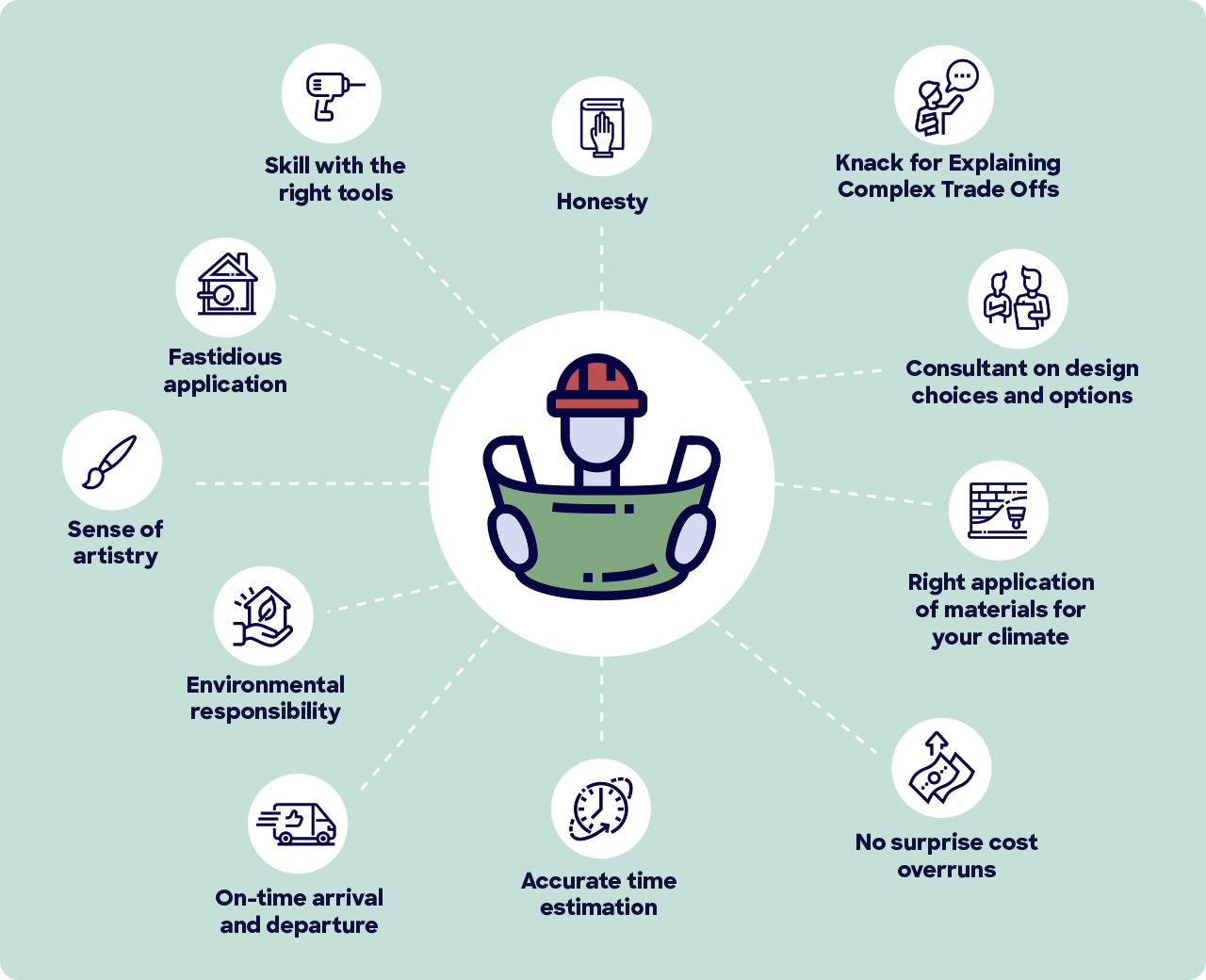
These reasons make labor quality the most important factor in considering the cost of a job, despite it being by far the most difficult to measure and gauge.
The hidden value of high-quality labor applies to virtually every other project category. A talented kitchen remodeler can guide toward the most effective layout for hosting and cooking, in addition to all of the above. A talented roofer will think about not only waterproofing, but also ensuring the maximum lifespan of your facia and flashing. They will think through gutters and your entire water management system, with thought to drying, drainage and mitigation. You might find out during an intense weather event many years later that a low-quality roofing contractor did not think through these things.
These reasons make labor quality the most important factor in considering the cost of a job, despite it being by far the most difficult to measure and gauge. Fortunately, there are ways for consumers to assess quality, such as:
- Reading reviews thoroughly from trusted marketplaces.
- Asking for referrals and calling them.
- Checking for licenses and work history.
- Asking for photos or videos of recent work.
- Having frank conversations about their timeline and budget expectations, as well as what assumptions they’re making in setting them.
Regardless of the method a consumer uses to check for the quality of their pro, high-quality labor will be more expensive, but that is a good thing. And, for the value a high-quality pro brings to the project, it is also truly a bargain.
Summary
Homeownership is part of our American cultural identity; however, once we become homeowners, there is no manual to help us care for, maintain or update our homes. For homeowners, one of the biggest sources of uncertainty is around the cost of home services. Cost matters in every industry because it dictates the relationship between consumers and suppliers and drives how we prioritize, value and shop for goods and services. Every dollar paid by one person is someone else’s income.
In home services, cost and pricing are particularly important because homeowners are more immediately exposed to the entire value chain of the process – since so much of the work is taking place in their own home – in contrast to other parts of the economy like consumer electronics, where the work is all completed as part of a complex and highly optimized supply chain. Home services are how we care for, maintain and improve one of our biggest financial assets: our homes. The more we know about the pricing and cost of home services, the more we can make smart investments in our homes.
Pricing for home services is a function of four things: material quantity, material quality, labor quantity and labor quality. Each is important, but labor quality is arguably the most important and the hardest to measure and understand. While some labor can appear outwardly expensive, great labor is ultimately a bargain considering the hidden skills, talents, wisdom, capabilities and other beneficial attributes of a skilled tradesperson.
Over the past year, we have seen changes in home ownership and a general boom in real estate. The rising prices of real estate in some areas across the country is well documented; however, changes in cost and pricing to home services due to the COVID-19 pandemic are not. So, did the COVID-19 pandemic cause changes in the cost and prices for home services?
Yes. Topline costs increased nearly across the board for most of the top 20 most popular projects. Exactly how COVID-19 changed prices is harder to say, but our pricing model looking at each of the four major components of project price – materials quantity, materials quality, labor quantity, and labor quality – suggests that the most likely culprit was an increase in materials cost at most quality points. Scarcity and factory shutdowns, supply chain disruptions and greater consumer demand pushed lumber and other prices higher at most quality points, in turn driving higher total project costs independent of changes in material quantity.
Looking forward to 2021, the most planned projects will likely remain elevated in cost, with the potential for further price inflation. Regardless of how much materials cost or how much one chooses to spend on their overall project, one thing remains constant: investing in quality labor is always a bargain.
Methodology & References
2020 project price data included in the True Cost Report is based on internal HomeAdvisor marketplace data of median costs for projects requested between January 1st and December 31st, 2020. Project costs are calculated based on a rolling median of consumer reported pricing for jobs completed through HomeAdvisor.
Price variance is calculated by dividing the standard deviation by the mean of prices reported between the 1st and 3rd quantile. This reduces the effect of outliers on estimating common cost variance.
Surveys of consumer spending priorities are conducted by HomeAdvisor’s internal research team and weighted to match the general population. Spending priorities for the top projects in 2020 and the top planned projects in 2021 came from a survey of 1,400 US adults. The survey used post-sample weighting of multiple demographic attributes to develop a representative sample of the entire U.S. population. This is a groundbreaking level of detail on home spending that provides new insights into how people spend on their homes.
Contacts
For information about this report or other research or analysis questions, you can contact the HomeAdvisor Research team:
HomeAdvisor.com/research
Mallory Micetich
Vice President, Corporate Communications
ANGI Homeservices, HomeAdvisor, Angie’s List
publicrelations@homeadvisor.com
Mischa Fisher
Chief Economist
HomeAdvisor
research.economics@homeadvisor.com
The material and information contained in this report is for general information purposes only. You should not rely upon such information as a basis for making any business, legal or any other decisions.
